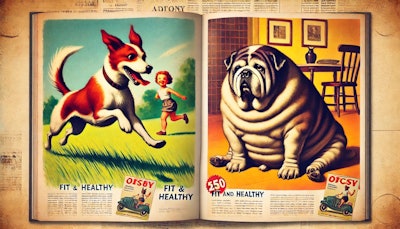The humanization of pets has included the humanization of pet diseases. As with people in many regions, the health problems associated with obesity outweigh the dangers of malnutrition and starvation for dogs and cats. Despite the prevalence of pet obesity, veterinarians continue to face challenges in communicating the dangers of pet obesity. Talking to people about the reduction in pet life expectancy associated with obesity can be particularly influential. In a survey of 1,108 dog owners, life expectancy was ranked as the most important aspect of obesity-related communication with veterinarians (relative importance: 28.56%), while price change was less relevant.
“By incorporating information important to clients into these conversations and emphasizing the positive impact of achieving or maintaining an ideal weight on life expectancy, veterinarians can more effectively support their clients in taking steps to prevent or treat obesity in their pet,” the researchers wrote in the Journal of the American Veterinary Medical Association.
The second most important piece of information in obesity-related messages was the time frame for developing arthritis (19.24%). The study authors referred to previous research showing that the most important aspect of effective treatment and prevention of osteoarthritis is achieving and maintaining a lean body through appropriate diet and feeding practices.
“This lifelong study looking at dietary restriction and aging in dogs found that maintaining an ideal body condition score through dietary restriction significantly delayed the onset of diseases of aging, particularly osteoarthritis,” they wrote. “Veterinarians can use these findings in both their preventative weight discussions and in discussions with clients about obesity, emphasizing the direct link between weight management and joint health. In this way, veterinarians may have the opportunity to proactively improve the overall well-being of dogs and reduce the risk of obesity-related diseases in dogs.”
Just surviving is not enough. A dog’s future quality of life was the third most important issue in veterinary communications about obesity (18.91%). Quality of life can be difficult to define, and researchers suspect this ambiguity is related to its lower importance to dog owners.
Costs for weight-based dog food
Closely behind the quality of life was the change in food costs (18.90%).
“When changing the cost of food attribute, participants preferred diet recommendations with a cost increase of CAD$0.19/day compared to baseline, followed by a preference for no price change,” they wrote. “These results suggest that participating dog owners may not have considered cost as the most important factor when deciding to manage their pet’s weight loss and that they are open to at least some cost increase when deciding to manage their pet’s weight loss. It is also possible that the cost per day representation is not typical of how owners think about the cost of feeding their pet, as opposed to the total upfront cost of a single diet purchase. Preferences elicited by DCE studies should not be interpreted outside the context of the attributes and levels used in a single study. Therefore, further research examining the role of a pet owner’s willingness to pay in taking action to treat their pet’s overweight or obesity is needed. Future research into pet owners’ cost tolerance should specifically examine their willingness to pay in the context of their understanding of the potential benefits of weight control for their pet.”
Pet food industry professionals can incorporate these findings into their consumer education efforts, focusing on the impact of obesity on life expectancy, arthritis prevention, and the overall benefits of maintaining an ideal body weight. Communication tailored to these pet owner priorities can ultimately improve pet health and longevity.


